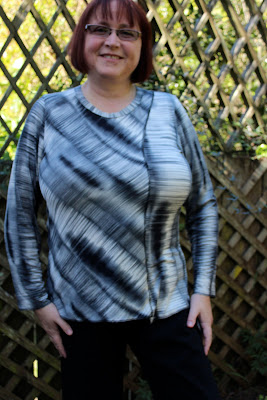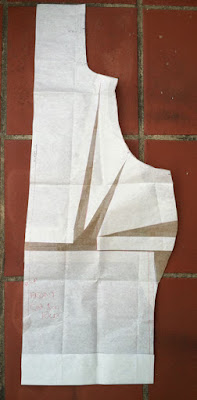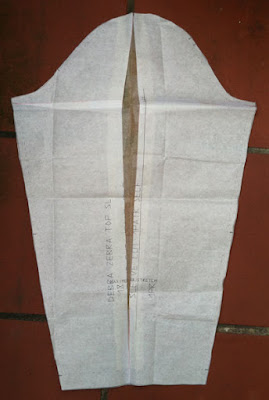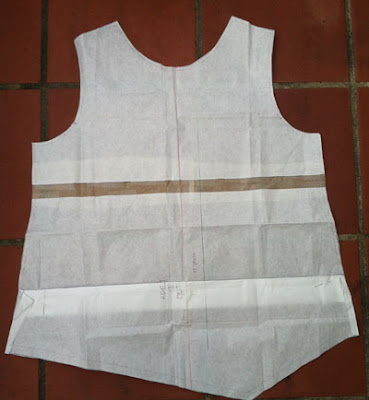
Quick links:
- Patterns with Built-in Bust Darts
- Are You Uber Busty?
- Altering a Pattern for Woven Fabrics to fit the Uber Busty
- Altering a Pattern for Knit Fabrics to fit the Uber Busty
- Negative Ease
- Pictures of Alterations
- Breast Reduction - Yay or Nay
This post has been a long time coming. I mean, it's pretty hard to avoid the fact that I am mostly boobs. My current bras (I have three in varying states of decay) are 36G... and they are actually too small, purchased when I weighed 20 pounds less. When I sit cross legged and bra-less... well you can imagine the rest.
When I was nursing my babies (a very difficult challenge for reasons I won't go into on the blog), one of my major personal milestones was when the baby's head would finally grow larger than my breast, and it took months. TMI? Sorry. :)
Patterns with Built-in Bust Darts
Before I proceed, I want to put something out there. I really dislike patterns that come with bust sizing. This might surprise you. I dislike them for two reasons: First, the cup size range offered usually ends at D and is nowhere near big enough to fit me. Second, the dart is completely in the wrong place. It is much easier to start from scratch and add a bust dart than to move and enlarge one. I just had to say it, because I have been told by more than one pattern designer, that their patterns "just work".
Generally these pattern designers have a petite (or regular sized) bust.
Are You Uber Busty?
My full bust measurement is 10 inches larger than my waist and 12 inches larger than my hips. So, yes, I have a unique fitting challenge. In fact, I don't consider a D, or even a DD cup, to be large. Of course, that is a large bust, but I have an uber large bust. Are you busty? Or uber busty? Once you can no longer easily buy a bra in Nordstroms without special ordering and are looking at cup sizes like G, H and I, you have entered uber busty territory.
But doesn't everyone have fitting challenges? Yes, I am quite limited in the styles I can wear up top. But isn't everyone limited in the styles they can wear? Every so often I truly yearn to wear a design that I know is totally impossible, but that is hardly unique either. When this happens, I whinge for a minute and then I remind myself that I can wear all sorts of great pants styles and move on. Women who are uber short, uber tall, uber small busted, highly asymmetric, all have fitting difficulties.
Despite this fact, I don't post tutorials on how to fit my bust. This is for a couple reasons:
- There are many resources available that already cover this topic. My favorites are:
- Fit for Real People, 2nd Edition, a book by Palmer/Pletsch. (The second edition describes the Y-dart.) This excellent book on fitting is often referred to as FFRP.
- Full Busted, a DVD by Palmer/Pletsch.
- Debbie Cook has some good tutorials on her blog, Stitches and Seams.
- Even where I have gathered special knowledge on fitting my own bust, I am reluctant to post exactly how I deal with it. Maybe this is cowardly, but it's partly because I don't want flak about my approach being "wrong". And, every situation can vary. You have to learn the particularities of your figure — become the master of fitting your body. I am not great at fitting patterns. I am great at fitting patterns to me.
So, I tell you, I have approaches that work for me: an uber busty, but hipless wonder. My measurements are, pretty much, 50-40-38. One of the big reasons I started my blog, over two years ago, is because the uber busty is a body type that one doesn't see much, outside of porn stars or Dolly Parton, and I wanted to represent this segment of sewists.
Also, when the boobage is fake, the fit might be a challenge, but it's a slightly different challenge. Fake uber boobs are generally much higher up on the body - I always have to lower the bust point on a pattern by 2", maybe more. Women with fake uber boobs usually have slim upper arms and a strong shoulder line. I often have to enlarge the arm width on patterns, especially Style Arc or Jalie, which are drafted for a slim arm — the Palmer Pletsch book has the easy alteration for that. I also usually have to move the shoulder in by a couple inches, even on raglan styles or the shoulder "bump" is a couple inches down my sleeve. (Though I don't usually have to fiddle with the shoulder fit in Style Arc patterns, they are drafted to be much closer to my actual body. Many sewists of varying sizes comment that they love how Style Arc patterns fit through the upper chest and armscye.)
Altering a Pattern for Woven Fabrics to fit the Uber Busty
As I mentioned, there is a lot of information available on how to add a bust dart to a pattern for woven fabrics. I favor the Y-dart (covered in the Palmer Pletsch book), which is good for an uber bust. I routinely sew a size 18 or 20 (based on my upper bust measurement) in the Big 4 and add a 3" dart, for a total of 6" of width. Despite this, I always sew the darts and side seams last in a garment. This gives me an opportunity to place the dart exactly where it should go on the body — it can vary for each project. Once the dart is sewn I then pin the side seams, try the garment on, make any tweaks, and then complete the side seams — it is one of the last steps for me. So, I rarely follow the construction order given by a pattern, which usually has you sew the darts first thing. This is why my garments fit as well as they do (not that there isn't room for improvement...).
Another thing I do when altering a pattern (and I have mentioned this in several posts) is that, before adding the bust dart, I chop the pattern in half approximately at the waist. This is because my hips are so much smaller than my bust and much smaller than a size 18 pattern. Before I figured this out, the tops I made were generally tents. So I add the dart to the top half of the pattern, and then re-attach the bottom and kind of merge them together at the side seam. This can create a strange pattern shape and is another reason I always fit the side seams last in the garment - so I can tweak.
To give you a better idea of what I am talking about, in this post on the Liberty top, I show two versions that I made. The first version uses a standard FBA, extending to the hem of the garment. The resulting top has a tent-like, unflattering fit. The second top, uses my modified approach and creates a much better fitting garment. The following images are borrowed from that post:


Both versions.
Left: Size Large with standard 2" FBA. Right: Size Medium, sliced at waist, 3" Y-shaped FBA on top, bottom re-attached, and side seam merged.
Result: Much better fit through the hips.
Another way to prevent the "tent" effect, rather than chop the pattern at the waist, is to sew fisheye darts from the bust to the hem. You might be wondering why I do not make more liberal use of the fisheye dart. However, I am not a fan of this approach. It works fine if you have a relatively small belly, but I do not. This technique can work well for a conventional blouse, and I have used it once or twice in that situation, but it does not work well for the more unusual styles I favor. I mean, can you imagine the Sewing Workshop Liberty top with fisheye darts? I don't think so. If your pattern is asymmetric, or has an unusually seamed hem, a fisheye dart is not likely to work.
Altering a Pattern for Knit Fabrics to fit the Uber Busty
I know that knits intimidate many sewists, and I don't really get that. At the age of 11, in 1970, my mother (an amazing sewist and an A-cup wonder who didn't get how to fit my body at all when it suddenly exploded at age 16) signed me up to take a sewing class at a local Stretch and Sew store.
Back then, there was no such thing as lycra. Imagine that! Knits were generally cotton interlock, qiana (a nylon fabric somewhat similar to the ITY and slinky poly knits you see today, except less breathable), or wool double knits. Stretch and Sew was the bastion of cotton interlock, having built their empire on that particular form of knit, which is a very stable, but not highly stretchy, doubleknit.
So, I have been sewing with knits for a long time. It's true that they require some light handling and a good machine, but I find them to be, in most cases, a delight to sew.
While there are many resources out there for bust darts, there is much less information available that specifically deals with knits. So, how do I handle an FBA in a knit? Well, it depends.
The first question you must ask yourself is, what kind of knit are you using? Is it a stable knit with some heft to it, such as a ponte? A wool double knit? A cotton interlock? These fabrics can handle a standard dart. Though I suggest you might be happiest with a dart that extends into the armscye, rather than the side seam. It will be shorter, less visible, and give a superior fit.
These kinds of knits are easy to sew because they are beefy and stable. For a knit like this, you may want zero ease in the finished garment. In other words, if your bust is 50", you might want the finished garment to be 50": 50" (garment) - 50" (body) = 0" (ease), called zero ease. This will skim your bust without tugging at it and it can look nice. But, to be sure, find a garment in your closet, or at the store (you DO carry a tape measure in your purse, don't you???), using a similar knit that fits the way you like and measure the bust. These days, clothing is more fitted and you might find that a garment that is larger than your bust is too loose. I know I do.
Or, are you sewing one of the flimsier, floatier, highly stretchy, knits such as a rayon- (or bamboo-) lycra jersey, a mesh knit, or a a slippery ITY polyester knit? You probably will not be happy with a dart in a knit like this. It is likely to be wiggly and draw attention where you don't want it. In this sort of garment, I add the FBA, but I don't sew the dart. I convert the point of the dart to a curve, and ease the fullness in at the side seam.
Negative Ease
In a garment made from a stretchy knit, I like to use negative ease. For me, 4" of negative ease is just perfect. For a 50" bust, I would fit the final garment to be 46": 46" (garment) - 50" (body) = -4" (ease), or 4 inches of negative ease. A bit of negative ease creates a garment that gently cups the bust, and the fabric below the bust comes "in" a bit, but doesn't hug the belly. The resulting fit is very flattering. To determine the amount of negative ease that you prefer, measure a garment made from a fabric with similar stretchiness and fits the way you like.
(By the way, when the garment measurement is larger than the body measurement, that is not called "positive ease", it is just called ease. Ease comes in two forms: wearing ease and design ease. Wearing ease is how much ease do you need to comfortably wear a garment. Design ease is purely aesthetic — how much ease do you add to create the design line you want?)
For example, here is a top I made recently and posted here that has 4 inches of negative ease:

But don't forget that the amount of negative ease varies according to the stretch of the fabric. In this garment, posted in Sweatshirt Mashup - Jalie and Au Bonheur, I used a less stretchy fleece but forgot that it would need more ease. I used 4" negative ease and the result is a bit hoochie mama:

When adding a dart to a pattern for knits, I sometimes do not need much width to be added to the pattern at all because I do prefer negative ease. In this situation, I shortcut the alteration a bit. Rather than a normal FBA, which adds both width and length, I add length only: I slice the pattern horizontally at the bust point, lower the bottom part of the pattern by an inch or so, and possibly curve the outer seam at the bustline just a tad - but not too much! This adds the length I need to go up and over the bust, which you still need unless you like your front hemline to be too short.
Note: Remember, when you are adding a bust dart of any kind, that you need to add length, and not just width. This is because, your bust is a mountain and not a rainbow. (And, yes, I made this phrase up. :) )
When constructing the garment, and I am pinning the side seams, I ease the fullness in at the bust level. In other words, I start pinning from the hem so that the front and back are one to one; in the few inches at the top of the side seam, the front seam is longer than the back and I leave the fullness alone — I do not gather it. When stitching at the machine, I have one hand above the presser foot and one below, and I pull the seam so that they ease together. This is very easy because this kind of knit is stretchy. In the finished side seam, you will see slight puckering on the front side, but it works out fine on the body.
Pictures of Alterations
I have been asked for clarification of some of my pattern alterations. I pulled a few patterns and took pictures. These alterations were made on my Style Arc patterns.Seriously, I LOVE the fit I get from Style Arc and I use these patterns as my TnT (Tried and True) patterns and transfer the fit to other (non-Style Arc) patterns. Yes, shipping from Australia is expensive, but it's the same for our Aussie sewing sisters who order from the U.S. - maybe we need to develop Aussie sewing buddies so we can buy things for each other... And, yes, these patterns come in one size only. But I find that to be a treat - to just cut out the pattern on the lines and go.



Breast Reduction - Yay or Nay
Every so often, someone will ask me about breast reduction surgery. Often, it is from a well meaning person who has herself had breast reduction surgery and has been very happy with the results. While that's fine, I have never seriously considered this for several reasons. One, it is expensive. Yes, it can be covered by insurance if you have back problems, but, except for a few notable times in my 20s and 30s, I have never had back problems. I stand fairly straight and my back is generally fine.
Two, I am a complete weenie about surgery. Hate it. Don't want it. Avoid it.
And three, I like my bust. Not in the "I'm proud of my huge boobage" sort of way, but in the "Yes, I have big boobs and it would be convenient if they weren't quite so large, but they very nicely hide my enormous belly" sort of way. Seriously, if I magically woke up tomorrow with a C or D cup size, all you would notice is belly, and I far prefer a dominant bust over a dominant belly.
Besides, my kids, when young, really enjoyed my natural pillows, or Wilma and Betty, as we referred to them. ;)